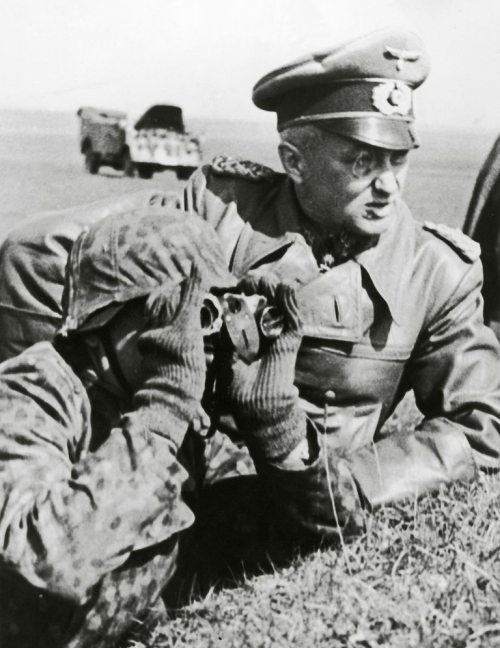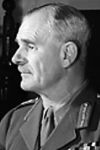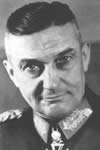Just What Are There 'Panzer' Divisions?
The War Illustrated, Volume 4, No. 89, Page 488, May 16, 1941.
What is this mighty instrument of war that the Germans, if they have not invented at least have developed to an unprecedented degree – this armoured force which smashed its way across Poland, France and the Balkans, which drove the British out of Libya, and is now feeling its way across the Egyptian deserts? Below we hive some details of Hitler's Panzerdivisionen, and of the counter-measures designed to halt their progress.
A Panzer division – Panzer is the German word for "armoured" – comprises 400 tanks, divided into two brigades of two battalions each, but in addition to the tanks, each division contains a brigade of infantry carried on motor lorries; a reconnaissance unit of motor cyclists; a regiment of field artillery; an anti-tank battalion; a heavy machine-gun battalion; an engineer battalion, equipped for bridge and road construction and repair; and a mobile repair and supply unit. Furthermore, it has attached to it a squadron of aircraft for reconnaissance and dive-bombing operations. Altogether, the number of vehicles is about 3,000, all motor-driven, and the number of men is some 14,000. But perhaps the most important fact about a Panzer division is that it is a self-contained unit, it is capable of acting on its own and does act as an individual army, receiving its direction from the divisional commander, who rides with his staff in the H.Q. armoured vehicle.
Germany has 15, or perhaps 16, of these armoured divisions, representing a total strength of more than 6,000 tanks. Three of the divisions are reported to be in Libya, and seven are believed to have been engaged in the fighting in the Balkans. Four sufficed to crush Poland, and ten triumphed in the Battle of France.
In each division there are usually heavy, medium, and light tanks. The fast light and medium models range from 18 to 20 tons; each is equipped with a 37-mm. gun (100mm. are a little short of 4 ins.), and 2 machine-guns, and its armour is about 30 mm. in thickness. It carries a crew of three. The heavy tank, which the Germans seemingly are coming to prefer, is a cruiser with a road speed of about 30 miles per hour. It weighs about 36 tons, but there has been talk of monsters of between 70 and 100 tons. Its armour is some 50mm. thick, and it carries a 75-mm. gun and two machine-guns. It has a crew of five, and can carry a heavy load of ammunition. A model PZWK 6 shown in Berlin in 1939 had armour 50 to 60 mm. thick and carried two guns of 75 mm. or 105mm. and a 47-mm. anti-tank gun; its crew numbered eight.
When going into action the Panzer division seeks to outflank, rather than to make a frontal attack. If, however, it is not possible to work round the enemy the motor cyclists and the light motorized unit probe the opposing defences, searching everywhere for a soft spot. As soon as this is found a wedge is driven in by dive-bombers and heavy tanks.
Once the line is penetrated, then the tanks spread out like an opening fan; and behind them, through the gap which they have caused, pour the rest of the Panzer division. Far and wide throughout the countryside speed the motor cyclists and the light tanks, the heavies, the flying artillery, spreading confusion and destruction. The enemy communications are first threatened, then disrupted, severed, smashed. The civilian population are driven from their homes and become panic-stricken mobs. The opposing troops are cut off into isolated pockets of resistance, which may continue firing hours after the main battle has swept past and beyond them; they are left to be dealt with by the motorized infantry. So what was once a nibble has become a thrust; what was once a crack is now a breach, through which rushes a flood of armoured troops not to be withstood.
Not to be withstood – at least, not by lines of defence, by trenches and concrete positions, such as are the delight of the military engineer, who thinks still in the terms of the battles of the last war, of the Somme and of Arras, of Cambrai and Ypres. Nor are they to be withstood by those masses of infantry which still, to most people, constitute an army. It has been said that if the Yugoslavs had mobilized their millions, if Wavell had been able to send hundreds of thousands of men into the Balkans – then Greece would not have been overborne; there is still talk of the million Turkish bayonets which bar Hitler's way to the oilfields of the Middle East. But such suggestions, such talk, belong to yesterday. Millions of men armed with rifles and bayonets cannot stop Hitler's Panzerdivisionen; if they are flung into the battle against these armoured hordes they are doomed to be ground beneath the tractors into a bloody pulp. Even if they were supplied with masses of artillery, with thousands of anti-tank guns, even if they were supported by armadas of aircraft – still there is every reason to believe that the tanks, moving in unison under the direction of one audacious brain, would cut their way through to victory. Only one thing can beat the tank divisions – tanks, more tanks, directed with yet more skilful generalship, moved by supremer audacity. Thus it is not too wide of the mark to say that the battle against Hitler's Panzerdivisionen will be won in Britain's workshops.
Index
Previous article
Our Searchlight on the War
Eyes and Ears of the R.A.F. In future, by approval of the King, the Observer Corps is to be known as the Royal Observer Corps, in recognition of valuable services rendered over a number of years. T
Next article
I Was There! - They Call Us 'Ancient and Tattered Airmen'
Some of the Air Transport Auxiliary pilots who ferry aircraft from factories to R.A.F. stations are women – it was on this service that Amy Johnson lost her life – and here one of them describes h






